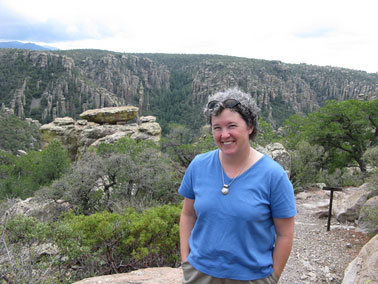| Dec 18, 2012 |
Sustainability scientist: Why don't we measure nature's capital?
|
|
(Nanowerk News) Sustainability scientist and professor Ann Kinzig says, while we do measure the bounty that nature provides, we fail to measure the intrinsic wealth that’s found in natural goods. That’s the reason why our inclusive wealth is not growing, and one of the reasons why we haven’t achieved sustainability.
|
|
“On our national accounting and indices, we track some forms of wealth but not others,” Kinzig, a professor in the School of Sustainability and School of Life Sciences, says. “And when we don’t track something, we are sending the signal that it is not important – that we don’t need to take care of it.”
|
 |
| Ann Kinzig is a sustainability scientist and chief research strategist in the Global Institute of Sustainability, and professor in the School of Sustainability and the School of Life Sciences.
|
|
Kinzig discussed natural capital and the wealth of nature at the Arizona Science Center on October 26. As part of Arizona State University’s partnership with the Arizona Science Center, Kinzig was one of three prominent university researchers giving “lightning lectures,” or five minute talks about everything ranging from technology, to the environment, to health.
|
|
Kinzig asserts that the two main concepts in her talk, “The Nature of Wealth and the Wealth of Nature,” are vital to achieving sustainability. But if we fail to measure intrinsic natural capital, what do we track?
|
|
“We track the wealth in manufactured goods, but not in the creatures that may have inspired those goods,” she says in the lecture. “We track the wealth in our productive lands, but not in our national parks. We track the wealth in a tree when we cut it down to use it, but not if we leave it standing.”
|
|
These other sources of natural capital, or what Kinzig calls, “wealth of nature,” are the missing piece to expanding our overall wealth. Kinzig compares per capita assets in produced, human, and natural capital. Produced (or manufactured) capital grows the most each year, while human capital is slowly rising. But we are actually losing natural capital, causing our annual inclusive wealth to not grow as quickly as it could be.
|
|
“But it doesn’t have to be this way,” Kinzig says. “We can learn to understand the true nature of wealth. We can learn to track the wealth in nature, and in doing so, put ourselves on a more sustainable pathway.”
|
|
Kinzig says we can find solutions to our challenges by looking toward nature. For example, the leafcutter ants that can carry up to ten times their own weight. Or bucking rams that can butt their heads together without damaging their brains. The wealth of nature can lead to better conservation, improved human and environmental health, and successful economies.
|
|
Kinzig says, “Never stop wondering how we can make the world a better place, and never stop believing that we can.”
|

